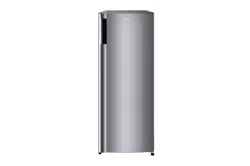Documents: Go to download!
- User Manual - (English)
- User Manual - (Spanish)
- PRODUCT SPECIFICATIONS
- PRODUCT FEATURES
- SAFE OPERATION
- STORING FOODS
- TEMPERATURE CONTROL AND DEFROSTING
- GENERAL INFORMATION
- GENERAL CLEANING
- BEFORE CALLING FOR SERVICE
- IMPORTANT SAFETY INSTRUCTIONS
Table of contents
User Manual Refrigerator
PRODUCT SPECIFICATIONS
The appearance and speci cations listed in this manual may vary due to constant product improvements.
Electrical requirements: 115 V, 60 Hz
Model | LROFC0605V |
Net weight | 82 lb (37 kg) |
PRODUCT FEATURES

SAFE OPERATION
1. Additional Grounding
The appliance must be grounded in order to prevent possible electric shock caused by current leakage.
Connect the grounding wire installed on the back of the appliance to the ground or another structure, according to local codes and ordinances.
2. Avoid Using Extension Cords
If possible, connect the freezer to its own individual electrical outlet. Install the freezer near enough to the outlet that you do not require an extension cord.
3. Starting the Appliance
When your freezer is first installed, allow the temperature to stabilize for 30 minutes. If the appliance is unplugged, wait 5 minutes before plugging it back in to avoid stress to the compressor.
Compressor will start operating 7 to 10 minutes after connecting the power cord.
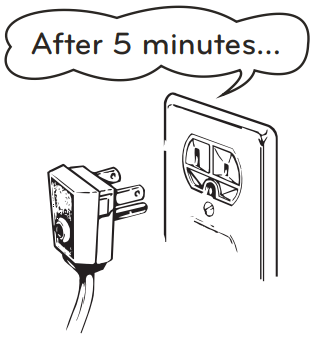
4. Replacing a Damaged Power Cord
If the supply cord is damaged, it must be replaced by the manufacturer or its service agent or a similarly qualified person in order to avoid a hazard.
5. Grounding Plug
I mproper use of the grounding plug can result in electric shock. Consult a qualified e lectrician or service person if the grounding instructions are not completely understood, or if you have doubts as to whether the appliance is properly grounded.
6. Long Vacation or Storage
Before leaving for a long vacation or placing the freezer in storage, unplug the appliance, clean the interior thoroughly, and prop the door open to prevent odors.
7. Power Outage
Most power failures that last only an hour or two will not affect the freezer temperature. However, minimize the number of door openings while the power is off.
8. Cleaning
Unplug the power cord from the power outlet for cleaning or servicing. To avoid electric shock or injury, do not touch the power cord with wet hands.
STORING FOODS
This appliance can be used for both freezing and "soft freezing" food. Choose the proper storage location and temperature control setting for the desired results.
Top shelf, door bins (S1, S2): Use for soft freezing
Main shelves (F): Use for freezing
Drip tray (S3): Use for defrosting (Do not use to store food)
CAUTION:
- Do not place ice cream or frozen dairy products on the top shelf or in door bins.
- The drip tray has a maximum temperature of 21°F (-6°C). Make sure that the drip tray is properly installed before defrosting.
- For best results, store frozen food on the main shelves (F). During defrosting, the warmer temperatures in the soft freeze areas will shorten the storage life of foods.
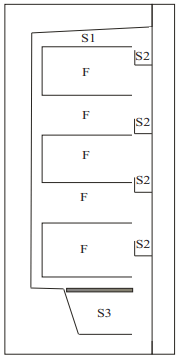
- Before storing food, cover it with vinyl wrap or store it in a container with a lid. This prevents moisture from evaporating and helps food to keep its taste and nutrients.
- Allow hot food to cool prior to storing. Placing hot food in the freezer could spoil other food and lead to higher energy consumption.
- Do not store bottles in the freezer. They may break when frozen.
- Do not refreeze food that has been thawed. Doing so can change the taste or nutritional value of food.
- Do not overload the door bins so that they prevent the door from closing properly.
- Do not open the door frequently or keep it open longer than necessary. Opening the door allows warm air into the freezer, raising the interior temperature.
- Do not store carbonated beverages in the freezer.
- Keep hands away from cold surfaces, especially when wet. Skin can stick to cold surfaces, causing frostbite.
- The temperature inside the freezer will not be affected by power outages lasting only a few hours, as long as the door is kept closed. For longer power outages, place a block of dry ice in the freezer or remove food and cook it. When using dry ice, provide adequate ventilation. Dry ice is frozen carbon dioxide (Co2). When it vaporizes, it can displace oxygen, causing dizziness, light-headedness, unconsciousness, and death by suffocation. Open a window and do not breathe in the vapor.
- Opening the door for long periods can cause a significant rise in the temperature inside the appliance.
- If the freezer will not be in use for a long period, switch it off and allow it to defrost. Clean the interior and allow it to dry. Prop the door open to prevent mold from growing inside the appliance.
- Store raw meat and sh in suitable containers in the freezer, so that they are not in contact with and cannot drip onto other food.
TEMPERATURE CONTROL AND DEFROSTING
1. TEMPERATURE CONTROL
The freezer temperature changes depending on how much food is stored inside, the length and frequency of door openings, and the surrounding temperature. Adjust the temperature control dial to keep food at the desired temperature.
OFF (O): No cooling
MIN: Warmest temperature
MID: Recommended temperature for freezer (F) area MAX: Coldest temperature

2. DEFROSTING
- Defrost the freezer regularly to keep it working ef ciently.
- To defrost the freezer, turn the temperature control dial to the OFF (O) setting. Make sure that the drip tray is properly installed so water will collect in the tray. Once a month, unplug the power cord and allow the entire freezer to defrost.
- For faster defrosting, place 1 or 2 pans lled with warm water inside the freezer.
- Keep food well wrapped before defrosting. If food thaws, do not refreeze it. Either store the food in the freezer or cook and eat it.
- Once nished defrosting, remember to reset the temperature control dial to its original setting.
- Remove and empty the drip tray, dry it off, and reassemble it.
CAUTION:
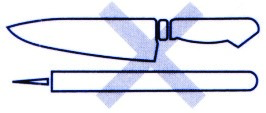
Do not use sharp implements or metal tools to remove ice or frost from the cabinet or the main shelves (evaporator). The resulting damage or punctured evaporators will not be covered under the warranty.
GENERAL INFORMATION
IF YOU MOVE
If you move, empty the freezer completely and clean the inside using a mild solution of baking soda and water. (2 Tbs. soda to 1 quart water) Be sure that the soda is completely dissolved to avoid scratching the inside of the freezer. Secure any loose items, such as racks, and bins. Do not try to move a loaded freezer.
ANTI-CONDENSATION PIPE
The outside wall of the freezer cabinet may get warm. Don't be alarmed. This is due to the anti-condensation pipe, which pumps hot refrigerant to prevent sweating on the outer cabinet wall.
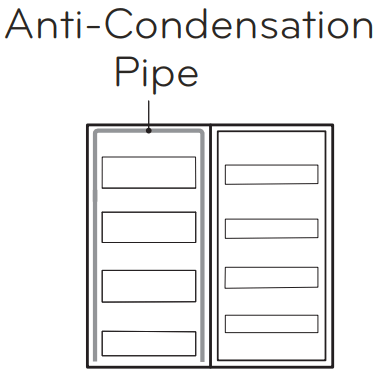
GENERAL CLEANING
1. It is important that your freezer be kept clean to prevent undesirable odors. Spilled food should be wiped up immediately, since it may acidify and stain plastic surfaces if allowed to settle
2.Before cleaning, u nplug the power cord from the outlet and remove all the food from the freezer.
Clean the interior using a mixture of baking soda and warm water. Mix 1/2 quart (0.5 l) of water with 1 Tbs. baking soda. Rinse and dry all surfaces. Do not use a powerful water spray to clean the appliance.

Clean the outside of the appliance with a solution of mild soap or detergent and water. Wipe with a clean, damp cloth and wipe dry with a soft cloth.
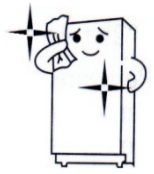
Do not use detergents or soaps to clean the interior, as the fragrance can linger. To prevent damaging plastic parts, do not use harsh chemicals such as thinners, gasoline, or boiling hot water. Never use metal scouring pads, brushes, coarse abrasive cleaners, strong alkaline solutions such as ammonia or bleach, or ammable or toxic cleaning uids on any surface.
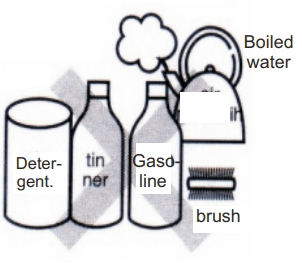
3.Do not expose the appliance or the interior to direct sunlight or heat sources.
4. Wipe up excess moisture with a sponge or cloth to prevent water or liquid getting into any electrical parts and causing an electric shock.

5. Clean the magnetic door seal area periodically to prevent mold and the buildup of food residue.
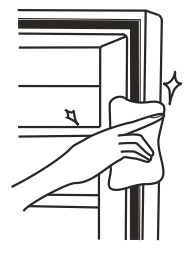
6. Allow the interior to dry completely before using the appliance.
7. For products with a stainless steel exterior, use a clean sponge or soft cloth and a mild detergent in warm water. Do not use abrasive or harsh cleaners. Dry thoroughly with a soft cloth. Do not use appliance wax, bleach, or other products containing chlorine on stainless steel.
8. Regularly clean any surfaces that come into contact with food. Keep the drip tray clean.
BEFORE CALLING FOR SERVICE
SERVICE CALLS CAN OFTEN BE AVOIDED.
IF YOU FEEL YOUR FREEZER IS NOT OPERATING PROPERLY, CHECK THESE POSSIBLE CAUSES FIRST:
PROBLEM | POSSIBLE CAUSES |
FREEZER DOES NOT OPERATE | • House fuse has blown or circuit breaker has tripped. • Power cord plug has been removed or loosened from the electrical wall outlet. |
FREEZER COMPARTMENT TEMPERATURE TOO WARM | • Temperature control not set to proper position. • Appliance is placed close to wall or heat source. • Warm weather and frequent door openings. • Door left open for a long time. • Large amount of food is kept in the freezer. |
ABNORMAL NOISE(S) | • Freezer is installed on a weak or uneven floor or leveling feet need adjusting. • Unnecessary objects placed behind of the freezer. |
FREEZER HAS ODOR | • Foods with strong odors should be tightly covered or wrapped. • Interior needs cleaning. |
CONDENSATION FORMS ON THE CABINET SURFACE | • Not unusual during periods of high humidity. • Door may have been left ajar. |
FREEZER IS NOT COOLING OR HAS NO POWER | • A fuse in your home may be blown or the circuit breaker tripped. Or the appliance is connected to a GFCI (Ground Fault Circuit Interrupter) outlet, and the outlet's circuit breaker has tripped. - Check the main electrical box and replace the fuse or reset the circuit breaker. Do not increase fuse capacity. If the problem is a circuit overload, have it corrected by a qualified electrician. - Reset the circuit breaker on the GFCI. If the problem persists, contact an electrician. |
IMPORTANT SAFETY INSTRUCTIONS
READ ALL INSTRUCTIONS BEFORE USE
Safety Messages
Your safety and the safety of others are very important.
We have provided many important safety messages in this manual an d on your appliance. Always read and follow all safety messages.
This is the safety alert symbol. This symbol alerts you to potential hazards that can kill or injure you and others. All safety messages will follow the safety alert symbol and either the word WARNING or CAUTION. These words mean: WARNING You may be killed or seriously injured if you do not follow instructions. CAUTION You may be injured or cause damage to the product if you do not follow instructions. |
All safety messages will tell you what the potential hazard is, tell you how to reduce the chance of injury, and tell you what may happen if the instructions are not followed.
WARNING: To reduce the risk of explosion, re, death, electric shock, scalding or injury to persons when using this product, follow basic precautions, including the following:
Installation
- To reduce the risk of injury to persons, adhere to all industry recommended safety procedures including the use of long-sleeved gloves and safety glasses.
- Never attempt to operate this appliance if it is damaged, malfunctioning, partially disassembled, or has missing or broken parts, including a damaged cord or plug.
- Only connect this product to a dedicated grounded electrical outlet rated for use with this product (115 V, 60 Hz, AC only). It is the user s responsibility to replace a standard 2-prong wall outlet with a standard 3-prong wall outlet.
- Do not use an outlet that can be turned off with a switch. Do not use an extension cord.
- The appliance must be positioned for easy access to a power source.
- When moving the freezer, be careful not to roll over or damage the power cord.
- Contact an authorized service center when installing or relocating the freezer.
- Do not, under any circumstances, cut or remove the third (ground) prong from the power cord.
- Keep packing materials out of the reach of children. Packaging material can be dangerous for children. There is a risk of suffocation.
- Do not install the freezer in a damp or dusty place where insulation on electrical parts may deteriorate.
- Do not place the freezer in direct sunlight or expose it to the heat from heating appliances such as stoves or heaters.
- • Do not bend or pinch the power cord excessively or place heavy objects on it.
Operation
- This appliance is intended to be used in household and similar applications such as:
- staff kitchen areas in shops, offices and other working environments;
- farm houses and by clients in hotels, motels and other residential type environments;- bed and breakfast type environments;
- catering and similar non-retail applications.
- This product is not to be used for special purposes such as the storage of medicine or test materials or for use on ships, etc.
- DO NOT allow children to climb, stand, or hang on the freezer doors or on the shelves in the freezer. They could damage the freezer and seriously injure themselves.
- Do not allow children to climb into the freezer. They could be trapped and suffocated.
- Children should be supervised to ensure that they do not play with the freezer.
- Keep fingers out of pinch point areas; clearances between the doors and cabinets are necessarily small. Be careful closing doors when children are nearby.
- Do not touch frozen food or the metal parts in the freezer compartment with wet or damp hands. Doing so may cause frostbite.
- Do not refreeze frozen food that has thawed completely. Doing so may result in a serious health hazard.
- Do not use an adapter plug or plug the power plug into a multi-outlet extension cord.
- If the supply cord is damaged, it must be replaced by the manufacturer or its service agent or a similarly qualified person in order to avoid a hazard.
- Do not operate the freezer or touch the power cord with wet hands.
- Do not modify or extend the power cord.
- Do not use an uncertified power outlet. Do not plug appliance into a damaged wall outlet.
- Do not put hands, feet or other objects into the air vents or bottom of the freezer. Doing so could result in personal injury or electric shock.
- In the event of a gas leak (propane/LPG), ensure the area is adequately ventilated and contact an authorized service center before resuming use. Do not touch the freezer or power cord of the freezer.
- Disconnect the power cord immediately and contact an authorized service center if there is a strange noise, odor, or smoke coming from the appliance.
- Do not use any fuse (such as copper, steel wire, etc.) other than a standard fuse.
- Do not place or use an electrical appliance inside the freezer, unless it is of a type recommended by the manufacturer.
- Do not put animals inside the appliance.
- Do not place heavy or fragile objects, liquid filled containers, combustible substances, or flammable objects (such as candles and lamps) on the appliance.
- If connected to a circuit protected by fuses, use time delay fuse.
- Keep ventilation openings, in the appliance enclosure or in the built-in structure, clear of obstruction.
- Do not use mec h anical devices or other means to accelerate the defrosting process, other than those recommended by the manufacturer.
- Do not use electrical appliances inside the food storage compartments of the appliance, unless they are of the type recommended by the manufacturer.
- Do not store explosive substances such as aerosol cans with a flammable propellant in this appliance.
Maintenance
- Do not use a hair dryer to dry the inside of the freezer.
- Do not light a candle to remove odors in the freezer.
- In the event of a refrigerant leak, move flammable objects away from the freezer. Ensure the area is adequately ventilated and contact an authorized service center.
- Keep flammable materials and vapors, such as gasoline, away from the freezer.
- This appliance is not intended for use by persons (including children) with reduced physical, sensory or mental capabilities, or lack of experience and knowledge, unless they have been given supervision or instruction concerning use of the appliance by a person responsible for their safety.
- Unplug the power plug before cleaning or repairing the freezer.
- Unplug the power plug immediately in the event of a blackout or thunderstorm.
- Turn the power off if water or dust penetrates into the freezer.Call a service agent.
- Do not store glass containers or soda in the freezer compartment. Contents may expand when frozen, break the container and cause injury.
- Do not store, disassemble or repair the appliance yourself or allow unqualified personnel to do so.
Disposal
- Junked or abandoned freezer are dangerous, even if they are sitting for only a few days. When disposing of the freezer , remove the packing materials from the door or take off the doors but leave the shelves in place so that children may not easily climb inside.
- If disposing of a freezer, make sure the refrigerant and insulation foam are removed for proper disposal by a qualified servicer. If you release the refrigerant or throw away the insulation foam, you may be fined or imprisoned in accordance with the relevant environmental law. Insulation foam contains flammable blowing gas.
- When discarding the appliance, remove the door gasket while leaving the shelves and bins in place, and keep children away from the appliance.
Grounding Instructions
- Improper connection of the equipment-grounding conductor can result in a risk of electric shock. Check with a qualified electrician or service personnel if you are in doubt whether the appliance is properly grounded. Do not modify the plug provided with the appliance; if it will not fit the outlet, have a proper outlet installed by a qualified electrician.
- Have a certified electrician check the wall outlet and wiring for proper grounding.
- Never unplug the appliance by pulling on the power cord. Always grip the plug firmly and pull straight out from the outlet. Failure to do so may damage the power cord, resulting in a risk of fire and electric shock.
Risk of Fire and Flammable Materials
This appliance contains a small amount of isobutane refrigerant (R600a), which is combustible. When transporting and installing the appliance, care should be taken to ensure that no parts of the refrigerating circuit are damaged. Refrigerant squirting out of the pipes could ignite or cause an eye injury. If a leak is detected, avoid any naked flames or potential sources of ignition and air the room in which the appliance is standing for several minutes.
In order to avoid the creation of a flammable gas air mixture if a leak in the refrigerating circuit occurs, the size of the room in which the appliance may be sited depends on the amount of refrigerant used. The room must be 10.8 square feet (1 square meter) in size for every 8g of R600a refrigerant inside the appliance. The amount of refrigerant in your particular appliance is shown on the identification plate inside the appliance. Never start up an appliance showing any signs of damage. If in doubt, consult your dealer.
CAUTION: To reduce the risk of minor or moderate injury to persons, malfunction, or damage to the product or property when using this product, follow basic precautions, including the following:
Installation
- Do not install the freezer where there may be a danger of the unit falling.
- The freezer must be properly installed in accordance with the Installation Instructions.
Operation
- Do not use aerosols near the freezer.
- This appliance is intended to be used only in domestic and similar applications.
- Do not strike or apply excessive force to any glass surface. Do not touch glass surfaces if they are cracked or broken.
- Do not overfill or pack items too tightly into door bins. Doing so may cause damage to the bin or personal injury if items are removed with excessive force.
Maintenance
- Do not use strong detergents like wax or thinners for cleaning. Clean with a soft cloth.
- Remove foreign objects (such as dust and water) off the prongs of the power plug and contact areas. Do not use a wet or damp cloth when cleaning the plug.
- Do not spray water directly on the inside or outside of the freezer.
- Do not clean glass shelves or covers with warm water when they are cold. They may break if exposed to sudden temperature changes.
See other models: LRFCS25D3S LRONC0705V LRBNC1104S WT7060CW WM4200HWA
